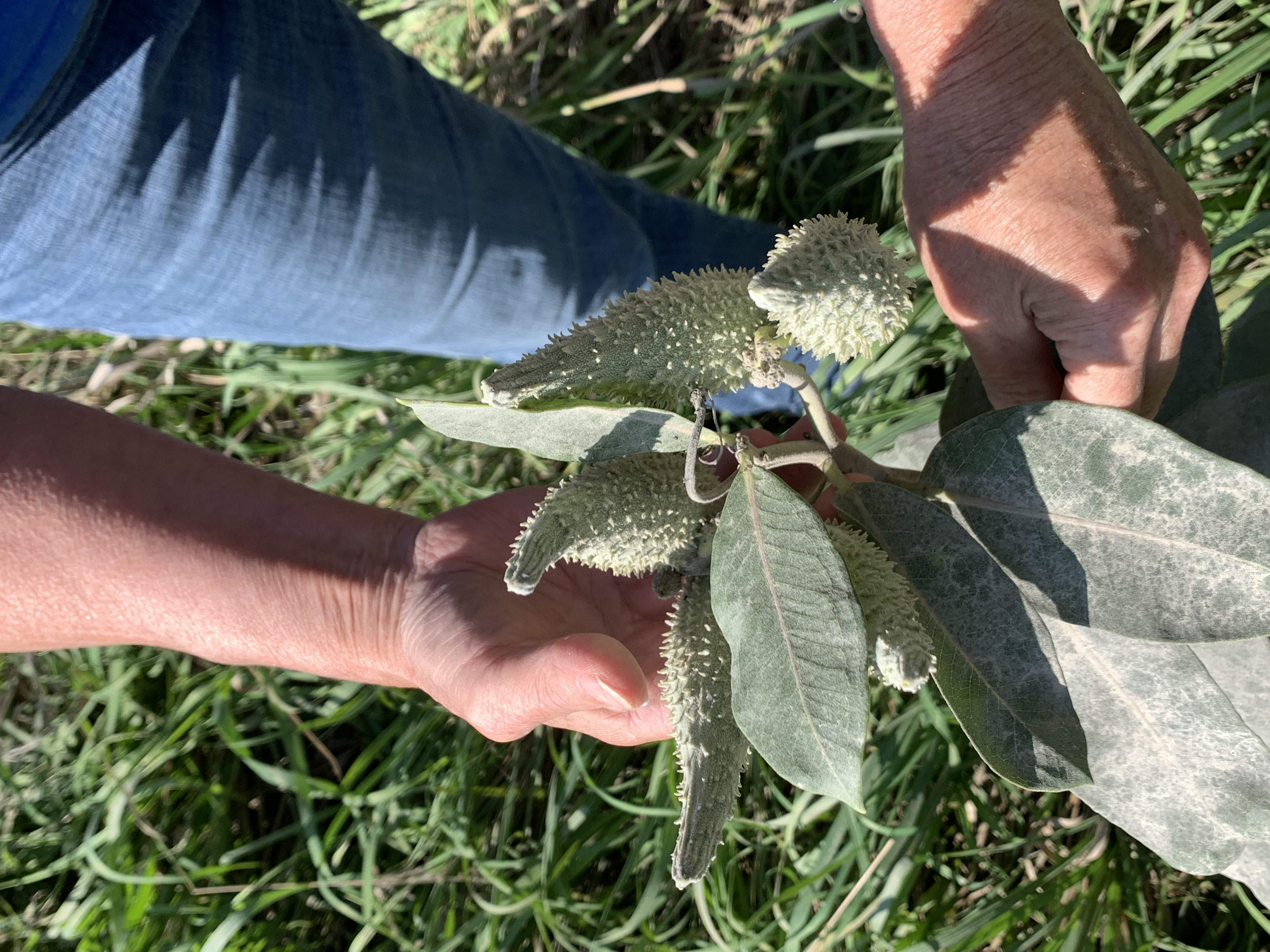There’s a clump of common milkweed (Asclepias syriaca) in the ditch on Owl Acres. This is a happy place for those beautiful and amazing monarch butterflies. The milkweed has hosted their larvae and now they’re getting ready to undertake that long and convoluted migration of theirs. But the milkweed they leave behind has its own story.
Seventy-two species of milkweed are native to North America. On Owl Acres, we have common milkweed. They were found in the southern plains before the prairies were converted to farmland. Now with all the disturbed soil along the roadside, in the fields and waste areas, they flourish, growing up to five feet tall. In the ditch beside the gravel road, there’s plenty of sunshine, and the gravel gives them one of their favorite types of soil—rocky soil with plenty of calcium in it. The milkweeds are covered so completely with rock dust they almost look white. They’re not white, of course. Their big leathery leaves and seed pods are green. The leaves grow in pairs from the bottom to the top of the single stalk. They are thicker than most leaves and grow up to 12 inches long. The leaves are darker green on top than underneath. At the top of the stalk, umbrella-shaped clusters of white to purple flowers bloom all summer long, sending out a pleasant fragrance. Each cluster has up to 100 tiny five-petaled flowers in it, and each plant has two or three up to five clusters blooming at the top of the stem.
I particularly like the milkweed pods. They grow where the flowers were at the top of the stem. Each pod is soft and nubby. It’s about three inches long and tapers to a point at the end farthest from the plant, sticking out like fingers. In the fall, after the seeds mature, the pods dry out and split open. Inside is a sticky white milky substance and rows of little seeds. Each seed is equipped with several tiny strands of floss. When they dry sufficiently, the wind takes hold of the floss and flies the seeds out and away. Milkweed is a perennial plant that drops its leaves in the fall. It has a well-established root system. So it will die back and go dormant until spring when new stalks grow to repeat the cycle.
Milkweed floss is made up of tiny hollow tubes of yellowish-white fiber, ideally designed to fly on the wind. It’s about six times more buoyant than cork. Because of this buoyancy, during World War II, it was gathered and used to stuff life jackets and flight suits for American troops. The fiber is too brittle to spin into thread, but it is said to be six times warmer than wool. So it makes good light-weight insulating fiber for jackets, comforters and mattresses. The long fibers in the stems of milkweed were used by indigenous people to weave into coarse fabric or to twist into twine and rope.
Milkweed has a long history as a poisonous and medicinal plant. The milky white sap that is spread through the plant, including its leaves, stem, roots and pods, contains glycosides which are poisonous but useful as medicines. The sap has traditionally been used on the skin to remove warts and ringworm. Roots were chewed to cure dysentery, and infusions of leaves and roots were made to ease coughs, asthma and fevers. More recently, the compounds called cardiac glycosides found in the sap have been used in modern medicine to treat heart disease.
Milkweed provides nectar and pollen for over 450 species of insects. It doesn’t make it easy, though. The pollen is served up in clumps called pollinia rather than the individual grains most pollen comes in. This makes transport heavier and harder for bees and other insects. And a bee can’t just fly in, grab the pollinia and take off. They have to get their legs just right by stepping into a slit, then pulling the leg out with the pollen bundle attached. The milkweed flower is said to be one of the most complex there is, and the monarch butterfly is not good at pollinating it.
The monarch butterfly is good, however, at laying her eggs on the leaves of the milkweed. The milkweed tussock moth does the same thing. The larvae hatch and eat the leaves of the milkweed. Along with their food, they ingest the sap containing poisonous compounds. The larvae aren’t bothered by the poison, but anything that eats the butterfly or the moth will get the benefit of the poison. The plant is poisonous to humans as well although some foragers have found ways to process it and eat parts of it. I guess I’d have to be pretty hungry to put milkweed in my salad though!
Photo by Author. Alt text: Karen’s hands are shown as she inspects a dust-covered common milkweed plant in the road ditch next to Owl Acres. Five nubby seed pods are clustered at the top of the plant.
